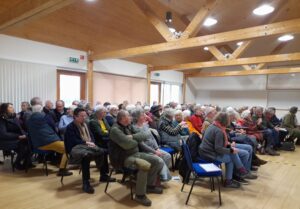On Saturday 11, 2023, the Friends of the St Mary’s, Udimore, arranged a talk, “A new Geography of the Norman Conquest” by well known author, historian and translator Kathleen Tyson, author of Carmen Widonis – The First History of the Norman Conquest. It was a fascinating listening to Kathleen Tyson’s thoughtful account, with maps, of how the Norman invasion and conquest really played out. She has an uncommon background with two disciplines of high-finance and geography. This experience seems to have played a definite role in giving her a unique perspective of the Norman Conquest which became a passion of hers.

Her book, Carmen Widonis, is an account that presents, through her transcriptions and translations of the contemporary record, another narrative of the battles. She includes the song of Bishop Guy d’Amiens, written in 1067, a Latin verse medieval poem of the contemporary record of the conquest. In her transcripts, opposing the translation of the poems, she adds explanatory notes, a running history and complimentary images from the other record of the Norman invasion, the Bayeux Tapestry.
Here is a quick reminder of the cultivated ‘truth’ so far:
23 years after King Edwards’ reign in England there were three men whose goal was to succeed on the throne as he had no heirs. First was Harold Godwinson, conveniently being King Edward’s brother-in-law. He insisted that Edward had said to him: “Into Harold’s hands I commit my kingdom after my death”. The second proclamation came from the Duke of Normandy, William, due to the blood relationship to King Edward and who also insisted later had promised him the kingdom. Arguing that William had violated the sacred oath, he gained enough support to invade England. The third rival was King of Norway, Harald Hardrada. The justification was that his nephew, Mangus, had made a deal with the Danish ruler of England. Neither had male heirs and entitled the other as heir of the kingdom in case death took either of their lives.
Norway’s Hardrada moves in on the northern English coast in September heading toward York, teaming up with Tostin, King Arnold’s brother, to get the throne. After the Vikings take the city, more battles ensue at Stamford Bridge in September 25. Harald wins, hears about the landing of William’s army near Hastings and he sails, ending up near the coast at Pevensey. He decides to march with his army to Hastings. On October 14 the battle starts with the Normans. William wins and is crowned King, at Christmas 1066 in Westminster Abbey.
 Kathleen Tyson feels, through extensive research, she can prove another narrative which is well documented in her book. One example is, she claims as an expert geographer, that the invasion battle did not take place at the sites of Hastings, Battle or Pevensey, but near Brede, just inland from Icklesham and Winchelsea on the Sussex Coast.
Kathleen Tyson feels, through extensive research, she can prove another narrative which is well documented in her book. One example is, she claims as an expert geographer, that the invasion battle did not take place at the sites of Hastings, Battle or Pevensey, but near Brede, just inland from Icklesham and Winchelsea on the Sussex Coast.
What is the truth? Maybe best read her book which costs £25 from Amazon. Attendees entrance fee for the talk, and there were nearly 80, will go towards maintaining the lovely Saxon/Norman church. Do keep an eye on the interesting events at the Udimore Hall. www.stmarysudimore.org
Image Credits: Heidi Foster .




The basis of the excellent talk by Kathleen Tysen on the Norman Conquest is “Carmen Widonis”, a Latin verse history recording the earliest and most complete account of the Conquest written by Bishop Guy d’Amiens in 1067. As Bishop Guy knew all the principals of the conflict personally, including King Harold, and it was written so soon after the event it is a little surprising that historians have not taken more notice of it.
Kathleen’s book is a fascinating read